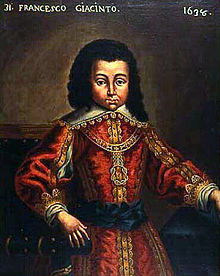Francis Hyacinth, Duke of Savoy
| Francis Hyacinth | |||||
|---|---|---|---|---|---|
 |
|||||
| Duke of Savoy | |||||
| Reign | 7 October 1637 – 4 October 1638 | ||||
| Predecessor | Victor Amadeus I | ||||
| Successor | Charles Emmanuel II | ||||
| Regent | Christine Marie of France | ||||
| Born |
14 September 1632 Castle of Valentino, Turin, Savoy |
||||
| Died | 4 October 1638 (aged 6) Castle of Valentino, Turin, Savoy |
||||
|
|||||
| House | Savoy | ||||
| Father | Victor Amadeus I | ||||
| Mother | Christine Marie of France | ||||
| Religion | Roman Catholicism | ||||
| Full name | |
|---|---|
| Francesco Giacinto di Savoia |
Francis Hyacinth (Italian: Francesco Giacinto; 14 September 1632 – 4 October 1638) was the Duke of Savoy from 1637 to 1638 under regency of his mother Christine Marie.
Born at the Castle of Valentino in Turin he was the eldest surviving son of Victor Amadeus I, Duke of Savoy and his wife Christine Marie of France. As the heir to the Savoyard throne, he was styled as the Prince of Piedmont. His parents had had another son but had died in 1628 prior to the birth of Francis Hyacinth.
At his father's death in October 1637, he succeeded and his mother took power having been claimed regent. While Duke of savoy he also held the subsidiary titles of Marquess of Saluzzo, count of Aosta, Moriana and Nice, and claimant King of Jerusalem. The infant was nicknamed the Flower of Paradise (French: Fleur de Paradis)[1]. Having succeeded his father at such a young age, Francis Hyacinth did not rule de facto being only 5 years old. Having caught a fever, he died at the Castle of Valentino, and was succeeded by his brother Charles Emmanuel II. The infant was buried at the Sacra di San Michele in Turin.
...
Wikipedia
